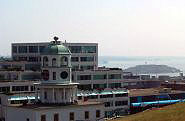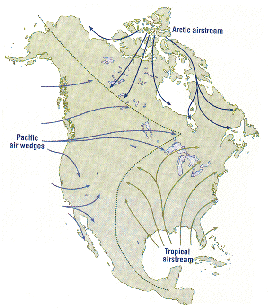Questions about smog
What is smog?
Smog is a term used to describe the mixture of pollutants in the air that we breathe. The main contributors to smog in Nova Scotia are ground level ozone (O3) and fine particulate matter (PM2.5). While we measure and talk about individual pollutants for simplicity's sake, it is more likely that we are affected by the "atmospheric soup" of all the different pollutants present in the air we breathe.
How is smog formed?
Smog begins to form when smog-forming pollutants [PM, sulphur dioxide (SO2), nitrogen oxides (NOx), ammonia (NH3), and volatile organic compounds (VOCs)] are released into the air. Further chemical reactions involving these pollutants can lead to the formation of O3 and more PM.
NOx + VOCs + (sunlight + heat) ![]() O3
O3
NH3 + NOx + SO2 + VOCs ![]() more PM
more PM
PM and O3 are the main components of smog.
Smog remains in an area until rain washes most of the pollutants out of the air, winds blow the pollutants away, or it undergoes further chemical reactions. Because it takes time for smog to form from precursor emissions, the highest levels are usually found in suburban and rural areas downwind of major emission sources.
Is smog a concern in Nova Scotia?
When we think about the air in Nova Scotia, phrases such as "refreshing ocean breezes" and "fresh, clear air" most often come to mind. However, air quality in the province may vary depending on location, time, season and weather conditions. There are some days where smog may cause health concerns for many Nova Scotians.

Halifax on a clear day

Halifax on a smoggy day
These two pictures compare the visibility on a clear day with that of a smoggy one. The clear day had an ozone concentration of 25 parts per billion, and a fine particulate concentration of about 2.5 micrograms per cubic metre of air. On the smoggy day we measured ozone concentrations of 50 parts per billion, and fine particulate concentrations of 50 micrograms per cubic metre.
In the winter, poor air quality tends to be more of a localized issue. This is especially a problem in areas where there is a high concentration of wood-burning homes.
Where does Nova Scotia's smog come from?
Smog in Nova Scotia is based on three factors:
- emissions from outside our region that are blown our way
- our own emissions
- weather conditions which transform these emissions into other pollutants that are more harmful to health.

North American air mass movement
We most often picture smog as something that hangs over large cities and large industrial sites. While it is true that most smog comes from these places, it does not stay there. Nova Scotia is downwind of some of the largest cities and industrial centres in North America. If you watch a weather forecast on television and see the directions that our weather patterns come from, it should not be surprising that air pollution follows the jet stream in the same way.
Nova Scotia does not have the same population or industrial base of upwind jurisdictions. However, our large per capita energy consumption, a strong dependence on fossil fuels, emissions from industrial and institutional sources, a heavy dependence on automobiles, and the use of other gas powered items contribute to air pollution locally and globally.

Nova Scotia industry

Downtown Halifax
Certain weather and geographical conditions tend to increase the effect of pollutants leaving smokestacks and tailpipes. In the summer, high temperatures and strong sunshine increase the formation of ground level ozone, while still air allows it to accumulate rather than disperse. This means most of our high smog days come in the summer time. Valleys are especially susceptible to high smog, as they slow down dispersion.
What effects does smog have?
The main human health concern about smog is its potential to affect the heart and lungs. This is of special concern to Nova Scotians. According to Statistics Canada's National Population Health Survey, Nova Scotia has among the highest rates of asthma and heart disease in Canada. While more research has to be done to determine whether air pollution is the cause of lung disease, there is little doubt that air pollution aggravates existing heart and lung conditions.
Young children, the elderly, and anyone with heart or lung disease such as asthma, bronchitis and emphysema are particularly sensitive to the effects of air pollution. Children and adults engaged in physical activities are also at risk because they breathe deeper and faster. Further information on the health effects from poor air quality is available from Environment Canada and Health Canada.
In addition to the impacts on human health, smog can harm vegetation, cause premature degradation of many materials, and affect visibility. This can lead to reduced production in resource sectors such as forestry, fisheries and agriculture. Hospital admissions and visits to physicians and emergency rooms involve direct costs to the health care system, as well as societal costs which are more difficult to quantify. Reduced productivity due to work and school absenteeism adversely affects the economy.
The SO2 and NOx emissions which lead to the formation of smog are also the main pollutants which cause acid rain.
